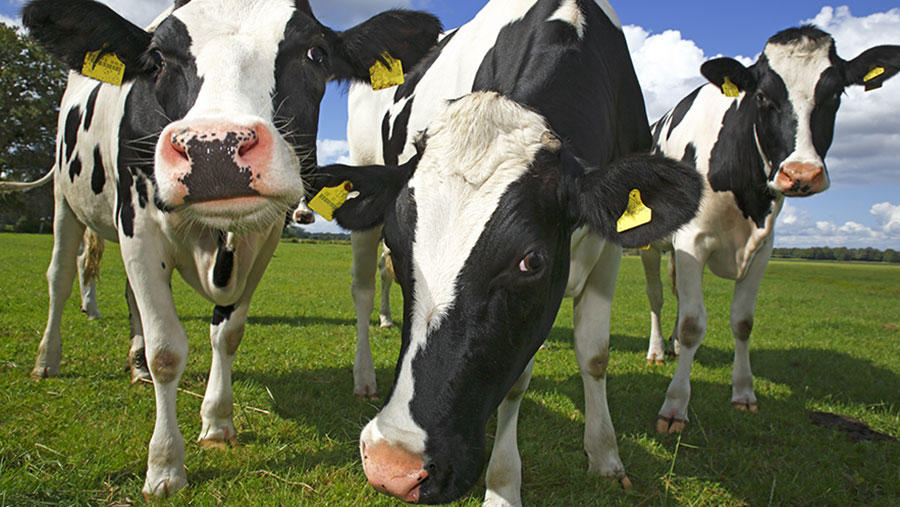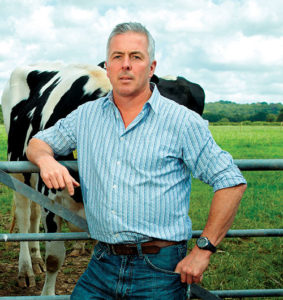Analysis: Free-range milk – separating fact from fiction
 imageBROKER/REX/Shutterstock
imageBROKER/REX/Shutterstock A new type of milk is making its way towards UK supermarket shelves, dividing opinion among producers and consumers in the process.
Its champions trumpet it as the “middle-ground” between retailers’ conventional, own-label offerings and organic milk.
Critics say its very nature divides the dairy industry at a time when it should be more unified than ever.
Free-range milk has been bandied as the answer to many of the inherent problems of the dairy industry; returning a fair price to farmers, guaranteeing happy, healthy cows and giving consumers more choice.
See also: Jamie Oliver and Jimmy Doherty fuel free-range milk debate
And there is certainly strong demand for increased options in the supermarket milk aisle, with a recent Twitter poll by television chef, Jamie Oliver, indicating 73% of the 6,471 people surveyed want a free-range milk offering.
Milk from pasture-fed cows commands a premium price – about £1.25 for four pints compared with £1 for four pints for most own-label milk – and provides a customer promise that cows are not housed all year.
Furthermore, a set proportion of the retail price is returned to the farmer.
What it means

Neil Darwent
However, the exact definition of “free-range” does differ between the two main offerings:
Neil Darwent’s Free Range Dairy guarantees herds whose milk carries his “pasture promise” have been outside for a minimum of 180 days a year.
Nick Hiscox’s Enjoy Milk brand proclaims cows will be outside “wherever possible”.
The aim of the pair of dairy entrepreneurs is simple: they want to add-value to a product that can fluctuate by more than four times in value from peak to trough.
This is dependent on what sort of contract the producer is on, and which market the milk is sold in to.
Between them, the pair have signed up hundreds of farmers, and both admit interest from other processors has increased since the subject of free-range milk was aired on Channel 4’s Jamie & Jimmy’s Friday Night Feast starring Jamie Oliver and Jimmy Doherty two weeks ago.
“We’ve had non-stop phone calls and emails from people wanting to find out where their nearest free-range supplier is,” says Mr Darwent.
“It’s time the public got the product they want, that also allows farmers to run a business and not chase a volume.”
Consumer support
Mr Hiscox also believes consumers have shown a clear desire to support British farmers and return some fairness to the supply chain, point to the success of the Morrison’s Milk For Farmers scheme as proof of this.
“The initiative asked consumers if they were willing to pay another 23p/litre for their milk and the answer was a resounding ‘yes’.”
The scheme has raised more than £5.8m for Arla’s 12,700 farmer-owners since it was launched in October 2015, overtaking organic sales over the 14-month period.
But Mr Hiscox has criticised the scheme for not sending all of the returns to UK producers, as has been promised by the two free-range initiatives – the proceeds under Arla have to be shared among all its European farmers.
“The concern I have is when we take advantage of the support consumers have shown us and abuse it by misleading them. We run the risk of a PR disaster,” he suggests.
Fact or fiction
However, misnomers and misleading facts have been all too common in a heated debate that has engulfed factions of the dairy industry since the Channel 4 segment on free-range milk was aired a fortnight ago.
The show pitted free-range, pasture-based herds against fully housed systems, with the show’s hosts making a number of claims as to free-range milk’s superiority (see Jamie & Jimmy’s Friday Night Feast false-facts debunked below).
Viewers of the episode could have been forgiven for leaving with the perception that herds that spend 365 days in doors were no different to battery chickens, with many members of the public expressing as much on social media.
“[The] current situation is appalling,” said Clare Taylor (@_mssct) on Twitter while Drew Macdonald (@drewmjmacdonald) said: “I had no idea that UK milk was that bad. I thought it was just USA that farmed milk like that.”
An article in The Times a few days earlier had also accused the two free-range milk offerings of further confusing an already complex dairy industry.
Even The Times showed a worrying lack of understanding of the realities of dairy farming, asking why free-range cows were not kept outside 365 days a year.
Of course, weather and grass growth would make this virtually impossible for the majority of regions across the UK. However, if a relatively well-informed national newspaper is confused, it is unlikely the consumer fully understands all of the nuances of the debate either.
Disappointment
Both free-range entrepreneurs have expressed their disappointment at The Times article, describing it as poorly researched and divisive.
“We aren’t two rival brands, nor are we in the business of creating horror stories about other systems,” says Mr Darwent.
“We want to differentiate and not discriminate in order to compete on a more positive footing.”
Mr Hiscox adds: “When someone [like The Times] makes silly comments, it’s always the producer who pays the price.
“There’s plenty of room for lots of different brands on the shelf, but the way to do it is through positive marketing and absolutely not bashing other systems.”
But, despite their common ground in many areas, the two remain resolute that their labels will go it alone, with no cumulative offering in the pipeline.
Good prospects in a tough marketplace
Fluctuating supply has led to extreme market volatility since milk quotas were abolished in March 2015.
EU production soared in countries such as the Netherland and Ireland, driving the UK farmgate prices through the floor.
The average price UK dairy farmers were paid for their milk dropped 20% to 19.95p/litre between March 2015 and the peak of the dairy crisis in July 2016.
While things are now improving, difficult market conditions have seen UK dairy producer numbers shrink by two-thirds in the past 20 years, to 13,355 in 2015. That was 3.33% down on the year before, according to AHDB Dairy.
But the omens for free-range milk seem positive; free-range egg sales have doubled in the past 10 years, accounting for about half total UK sales, while demand for cage eggs has largely flatlined.
Proponents of free-range milk believe a similar development is possible in the milk aisle.
But the infighting and risks of negative press need to stop, says NFU chief dairy adviser, Sian Davies.
“We all want to see successful products on sale, but what we don’t want is the knocking of other systems in order to get there.
“The industry is far stronger united and working together, fighting against the non-dairy alternative, highlighting everything that is great about milk.”
Ms Davies adds: “Dairy is facing a number of challenges in the next few years and the last thing we want is to create a level of confusion that exposes producers and retailers to negative publicity. That won’t help anyone.”
Jamie & Jimmy’s Friday Night Feast false-facts debunked
Livestock consultant and associate professor at the Department of Animal Science, Washington State University, Jude Capper sheds light on the truth beneath some of the statements made on Jamie & Jimmy’s Friday Night Feast (20 January).
Cows are happier if they are pasture fed
“There is little, if any scientific evidence that cow’s only being partially housed in a free-range system leads to a reduction in bullying as claimed in the programme.
“There isn’t an exact metric to measure cow happiness, but studies that assess, stress, productivity and contentment that have been carried out concluded that housing type and size made no difference to the impact of disease on an animal.
“Housed cattle are able to exhibit all natural behaviours that free-range cattle would – save for grazing.”
Cows want to be outside all-year
“Cows are similar to humans in the sense that they don’t want to be left out in the rain or adverse weather.
“If you visit a herd on a rainy or a muddy day you’ll see a queue of cows wanting to come inside.”
Milk tastes better if cows live in fields.
“This simply isn’t the case.
“The taste of milk is solely down to the constituents of feed, not the quality of milk.
“You can graze your free-range cows on wild garlic and the milk will taste correspondingly.”
There is something wrong with housed systems.
“There is a firm place for every dairy system in this country.
“There are good and bad examples of housed and pasture-based systems, the crucial element is how they are managed and individually run.
“In countries like New Zealand and Ireland, year-round grazing makes perfect sense, but it’s completely different here in the UK.
“We have an industry that needs to meet the needs of a growing population and a highly volatile industry.
“The last thing we need is to bash individual systems and leave consumers with the impression that housed herds are comparable to battery farms for hens.”
